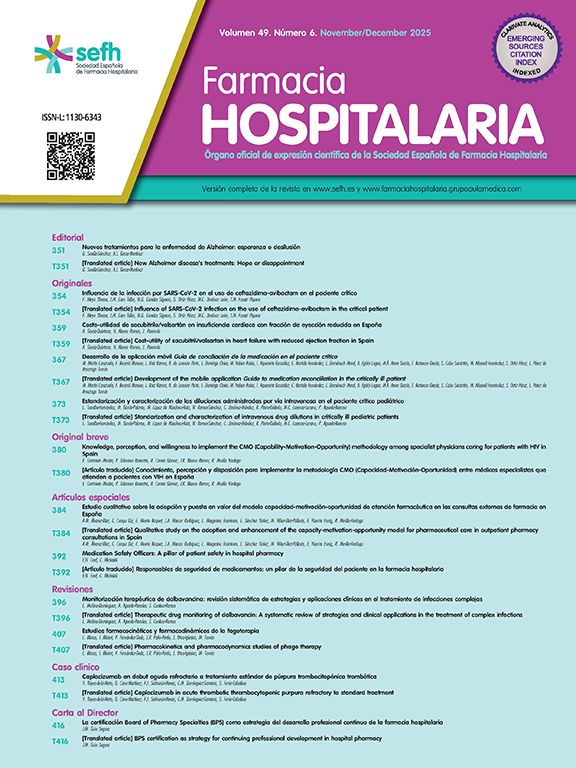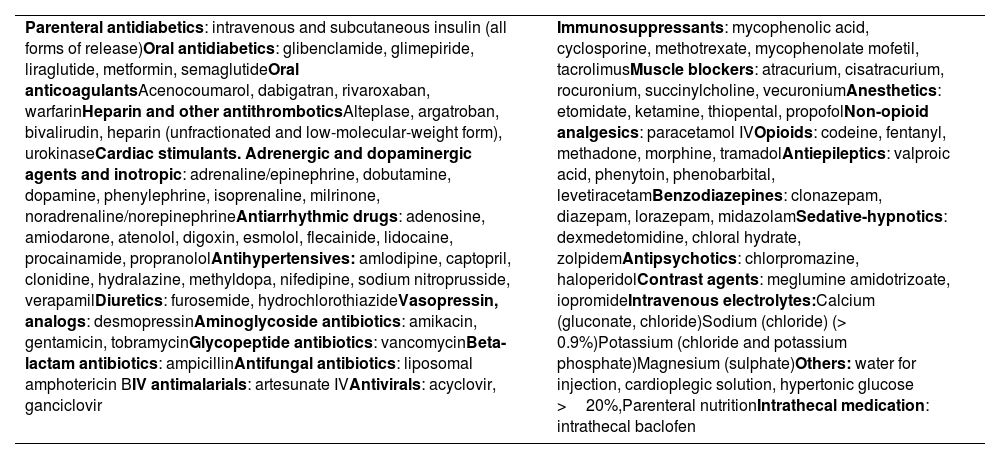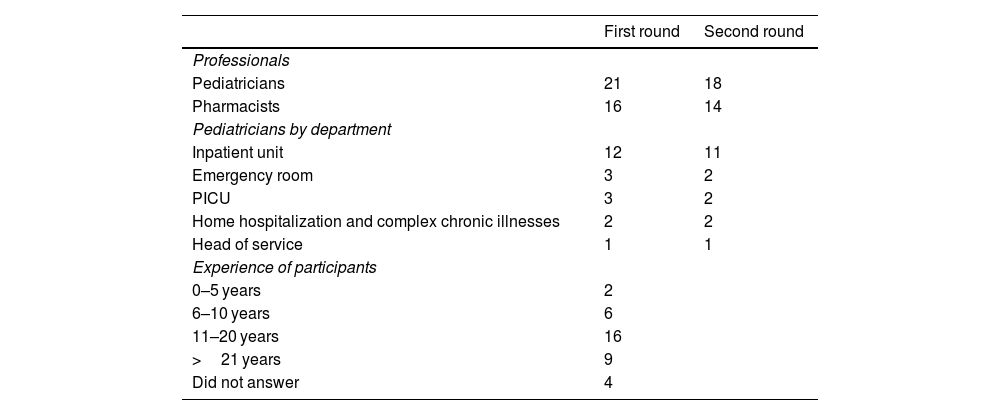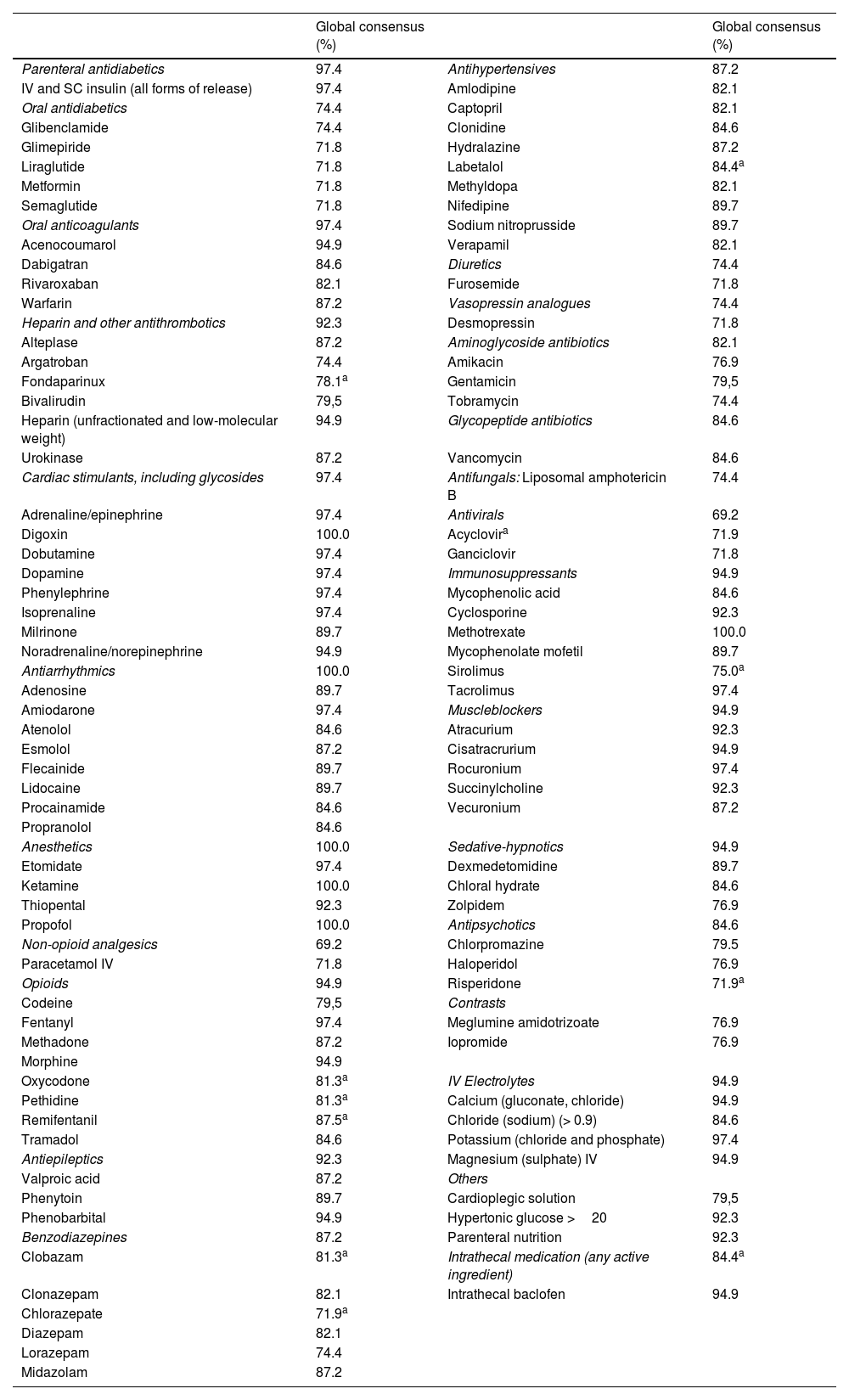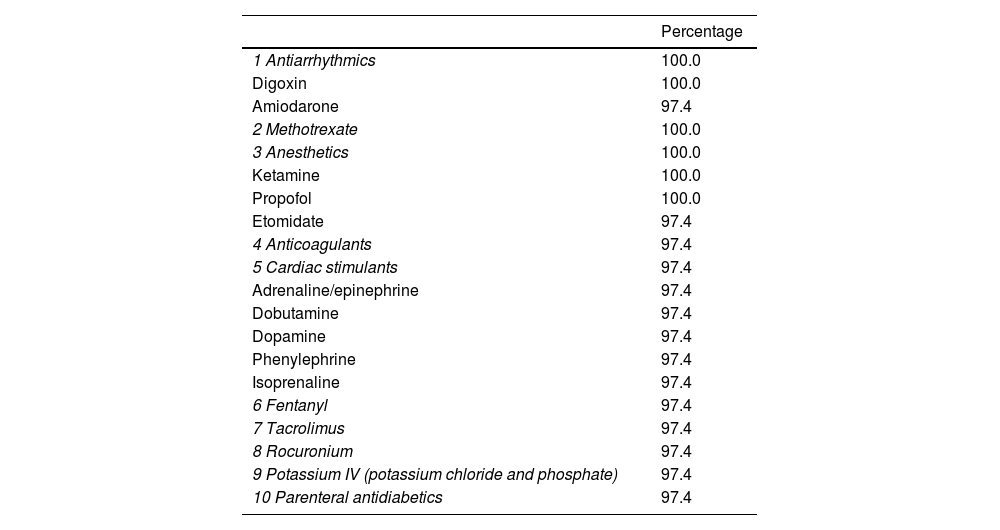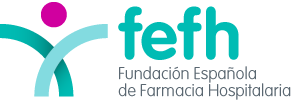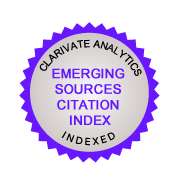Pediatric patients are more likely to experience medication-related errors and serious associated harms. The identification of high-risk medications (HRM) and their study in special populations, such as children with excess body weight (EBW), is a part of safety improvement strategies.
ObjectiveTo generate, through a consensus technique structured by an interdisciplinary group of pediatricians and hospital pharmacists, an operational and updated list of HRM for hospital use in children over 2 years of age. The document was part of a collaboration project between the Spanish Society of Hospital Pharmacists and the Spanish Society of Pediatric Hospital Medicine.
MethodsThe study was carried out in 2 sequential phases: (a) preparation of a preliminary list of HRM through bibliographic review and (b) subsequent application of the double-round Delphi method to agree on a definitive list of HRM. The results obtained were validated by calculating the probability of chance agreement and the modified Kappa statistic for each drug.
ResultsThe original list obtained by bibliographic review included 26 pharmacological classes and 96 drugs. Of the total of 37 experts, 32 (86.4%) completed both rounds of the Delphi. The final consensus list of HRM incorporated 24 pharmacological classes and 101 drugs. The modified Kappa statistic reflected a high percent agreement (94.9%) in the consensus reached by the participants.
ConclusionThis list can establish a tool for future studies and interventions to improve the safety of medications in general pediatric population, as well as in high-risk subgroups, such as pediatric patients with EBW.
Los pacientes pediátricos presentan una mayor probabilidad de sufrir errores y daños graves relacionados con la medicación. Dentro de la estrategia de mejora de la seguridad se encuentra la identificación de medicamentos de alto riesgo (MAR) y su estudio en poblaciones especiales, como los niños con exceso de peso corporal (EPC).
ObjetivoGenerar, mediante una técnica de consenso estructurada por un grupo interdisciplinar de pediatras y farmacéuticos hospitalarios, un listado operativo y actualizado de MAR de uso hospitalario en niños mayores de 2 años. El trabajo formaba parte en un proyecto de colaboración entre la Sociedad Española de Farmacia Hospitalaria y la Sociedad Española de Pediatría Interna Hospitalaria.
MétodoEl estudio se realizó en dos fases secuenciales a) elaboración de un listado preliminar de MAR mediante revisión bibliográfica y b) posterior aplicación del método Delphi de doble ronda para consensuar un listado definitivo de MAR. Los resultados obtenidos se validaron mediante el cálculo del probable acuerdo debido al azar y el estadístico Kappa modificado para cada fármaco.
ResultadoEl listado inicial obtenido por revisión bibliográfica incluyó 26 grupos farmacológicos y 96 principios activos. Del total de 37 expertos iniciales, 32 (86,4%) completaron las dos rondas del Delphi. El listado consensuado definitivo de MAR incorporaba 24 grupos farmacológicos y 101 fármacos. El estadístico Kappa modificado reflejó un alto grado de concordancia (94,9%) con el consenso alcanzado por los participantes.
ConclusiónEste listado puede constituir una herramienta para futuros estudios e intervenciones de mejora de la seguridad del medicamento en población pediátrica general, así como en subgrupos de riesgo, como los pacientes pediátricos con exceso de peso corporal.
A key component of the global strategy to improve patient safety is the identification of high-alert medications (HAMs),1 defined as those most likely to cause serious or even fatal harm if used incorrectly. The Institute for Safe Medication Practices (ISMP) has published a list of HAMs for the general population,2 which serves as a global reference for designing multiple interventions aimed at increasing hospital safety.
Pediatric patients are at a higher risk of experiencing medication errors and the serious consequences as a result of these errors.3 This increased vulnerability is attributed to intrinsic pediatric factors, such as pharmacokinetic and pharmacodynamic differences compared to adults and between different pediatric age groups, as well as a lower tolerance to adverse drug and excipient events due to physiological immaturity. Also contributing to this risk are factors related to the drugs themselves, such as narrow therapeutic margins or dose-dependent toxicity. In addition, limited information on the efficacy and safety of many drugs used in pediatrics often leads to off-label use. There is also a constant need for dosage adjustments due to the lack of dosage forms specifically adapted for the pediatric population.4,5
The severity of this safety issue is even greater in children with chronic diseases or special health conditions,6 such as those with excess body weight (EBW).7 In such cases, available information on drug use is often inadequate or entirely lacking.8 There is a need to prioritize research into the safety and efficacy of the most commonly used and/or high-risk medications in special pediatric populations, such as patients with EBW or other health conditions.
A major obstacle to conducting these studies is the absence of an official list of pediatric HAMs, which is highly needed due to the particularities of pharmacotherapy in children and adolescents. A number of initiatives have resulted in the creation of operational lists of pediatric HAMs. Some of the lists are based on expert opinion, whereas others are based on the results of consensus in different countries. These lists vary considerably in terms of care settings, scope, and quality of content.9–11 Such lists should be drawn up by the professionals directly involved in the management of young patients and should be updated regularly.
The aim of this study was to create an updated, operational list of HAMs for hospital use in children over 2 years of age, using a structured consensus technique designed by an interdisciplinary group of pediatricians and hospital pharmacists. This study is part of a research project to improve the safety of using HAMs in pediatric patients with EBW.
Material and methodsThis study was conducted in 2 consecutive stages: (a) the development of a preliminary list of HAMs through a literature review; and (b) the subsequent application of the double-round Delphi method to reach a consensus on a definitive list of HAMs.
This work is the result of an interdisciplinary collaboration between the Spanish Society of Hospital Pharmacy and the Spanish Society of Hospital Internal Pediatrics. The coordinating group, comprising 2 pharmacists and 2 pediatricians from each society, was responsible for developing a working protocol, drafting the initial questionnaire list, recruiting experts, analyzing responses from each round, preparing subsequent questionnaires, and overseeing the progress of the entire process. The panel of expert evaluators comprised hospital pharmacists and pediatricians from different hospital care settings (emergency departments, conventional hospitalization units, intensive care units, complex chronic disease units, and home hospitalization) across various in Spain. The methodological objective was to have more than 30 participating experts complete all phases of the Delphi process. Although there is no clear consensus on the minimum number of experts required for a Delphi process, some authors have suggested that 12–20 participants may be sufficient; however, to account for potential dropouts between rounds, it is recommended to include at least 30 experts.12
The preliminary list was created following a systematic and thorough search of Medline and Embase via Elsevier, SciELO Citation Index and Science Citation Index Expanded (SCI-EXPANDED) through the WoS main collection, as well as the LILACS, IBECS, BDENF and BINACIS databases via the Virtual Health Library. Search strategies were designed based on different combinations of keywords and MeSH terms through the title and abstract fields, which included at least the following terms: ([high-alert medication] AND [pediatric]). Results were restricted to studies in English and Spanish. We decided against applying a year of publication limit due to the number of references retrieved.
The preliminary list included active ingredients and pharmacological groups that were referenced in at least 2 studies or in a single study and in the ISMP list of HAMS for hospitals. Chemotherapy drugs were excluded due to their specific characteristics as well as any drug exclusive to the neonatal setting. The ISMP definition of HAMs was taken into account when compiling the list.
Panel members received a letter explaining the objective and design of the study and requesting their participation. Subsequently, a digital form was sent to members to collect information on their speciality, professional experience, and the level of agreement with the inclusion of each pharmacological group and active ingredient included in the preliminary list. For this purpose, a linear Likert scale was used, with 1 indicating complete disagreement and 7 indicating complete agreement. During this stage, expert panel members could also propose other pharmacological categories or groups for inclusion in the final list.
The consensus criterion for inclusion of a drug was that at least 70% of participants rated it 5 or higher. Drugs for which 70% of participants scored 3 or less were excluded from the initial questionnaire.13 The second questionnaire included drugs that did not achieve consensus in the first stage, along with active ingredients suggested by at least 2 experts. The same rating scale and consensus criteria were used as in the initial stage.
Finally, the coordination group prepared a final version of the HAM list including the active ingredients and pharmacological groups that achieved the required consensus in both stages, and the level of agreement achieved in each case.
Data collection was conducted using Google Docs.
The initial analysis of the results was performed using descriptive statistics to calculate the expert scores, using Microsoft Excel for Microsoft Office 365 (Microsoft Corporation, Redmond, WA).
The results were then validated using a modified Kappa statistic. The content validity index for each item (Item-level Content Validity Index, CVI-i) was calculated, adjusted for probable random agreement (Pa) using the formula: Pa = [N!/(A!(N-A)!)] * 0.5^N, where N represents the number of experts and A denotes the number of relevant agreements. Additionally, the modified Kappa statistic (K* = (CVI-i - Pa) / (1 - Pa)) was computed for each item of the instrument. The K* agreement evaluation criteria were as follows: poor for K* values lower than 0.39, moderate for K* values from 0.40 to 0.59, good for K* values from 0.60 to 0.74, and excellent for K* values greater than 0.74.14,15
ResultsThe literature search yielded a total of 230 references; 86 duplicates were eliminated, leaving 144 unique references for the selection process. After screening, 18 articles were selected for further review and 12 were excluded as they related to safety, medication errors, or safety measures to be implemented with HAMs. Finally, 6 articles were included that identified HAMs in different care settings9–11,16–18 as well as the ISMP Spain list of HAMS for hospitals.2
The initial list of HAMs comprised 96 active ingredients across 26 pharmacological groups (Table 1). Thirteen of the groups were not listed in the ISMP Spain list of HAMS for hospitals: antihypertensives, antibiotics (aminoglycosides, glycopeptides, and β-lactams), antifungals, antivirals, antimalarials, diuretics, non-opioid analgesics, immunosuppressants, antiepileptics, contrast agents, and antipsychotics.
Drugs included in the first Delphi round.
| Parenteral antidiabetics: intravenous and subcutaneous insulin (all forms of release)Oral antidiabetics: glibenclamide, glimepiride, liraglutide, metformin, semaglutideOral anticoagulantsAcenocoumarol, dabigatran, rivaroxaban, warfarinHeparin and other antithromboticsAlteplase, argatroban, bivalirudin, heparin (unfractionated and low-molecular-weight form), urokinaseCardiac stimulants. Adrenergic and dopaminergic agents and inotropic: adrenaline/epinephrine, dobutamine, dopamine, phenylephrine, isoprenaline, milrinone, noradrenaline/norepinephrineAntiarrhythmic drugs: adenosine, amiodarone, atenolol, digoxin, esmolol, flecainide, lidocaine, procainamide, propranololAntihypertensives: amlodipine, captopril, clonidine, hydralazine, methyldopa, nifedipine, sodium nitroprusside, verapamilDiuretics: furosemide, hydrochlorothiazideVasopressin, analogs: desmopressinAminoglycoside antibiotics: amikacin, gentamicin, tobramycinGlycopeptide antibiotics: vancomycinBeta-lactam antibiotics: ampicillinAntifungal antibiotics: liposomal amphotericin BIV antimalarials: artesunate IVAntivirals: acyclovir, ganciclovir | Immunosuppressants: mycophenolic acid, cyclosporine, methotrexate, mycophenolate mofetil, tacrolimusMuscle blockers: atracurium, cisatracurium, rocuronium, succinylcholine, vecuroniumAnesthetics: etomidate, ketamine, thiopental, propofolNon-opioid analgesics: paracetamol IVOpioids: codeine, fentanyl, methadone, morphine, tramadolAntiepileptics: valproic acid, phenytoin, phenobarbital, levetiracetamBenzodiazepines: clonazepam, diazepam, lorazepam, midazolamSedative-hypnotics: dexmedetomidine, chloral hydrate, zolpidemAntipsychotics: chlorpromazine, haloperidolContrast agents: meglumine amidotrizoate, iopromideIntravenous electrolytes:Calcium (gluconate, chloride)Sodium (chloride) (> 0.9%)Potassium (chloride and potassium phosphate)Magnesium (sulphate)Others: water for injection, cardioplegic solution, hypertonic glucose >20%,Parenteral nutritionIntrathecal medication: intrathecal baclofen |
IV, intravenous.
The questionnaire was sent to 39 experts: 21 pediatricians and 18 pharmacists. Table 2 shows the number of Delphi participants, as well as their experience and area of work, which, in all cases, was hospital pediatric pharmacy.
Number of Delphi participants and professional experience.
| First round | Second round | |
|---|---|---|
| Professionals | ||
| Pediatricians | 21 | 18 |
| Pharmacists | 16 | 14 |
| Pediatricians by department | ||
| Inpatient unit | 12 | 11 |
| Emergency room | 3 | 2 |
| PICU | 3 | 2 |
| Home hospitalization and complex chronic illnesses | 2 | 2 |
| Head of service | 1 | 1 |
| Experience of participants | ||
| 0–5 years | 2 | |
| 6–10 years | 6 | |
| 11–20 years | 16 | |
| >21 years | 9 | |
| Did not answer | 4 | |
PICU, pediatric intensive care unit.
The questionnaire was completed by 100% of pediatricians and 88.9% of pharmacists in the first round, and 85.7% and 77.8%, respectively, in the second round.
In the first round, the agreement level was 93.8%; 22 new drugs were suggested by at least 2 participants, which were included in the second round. All drugs reaching consensus in the first round (with 70% of participants rating 5 or higher) showed an excellent K* index (K* > 0.74), except for ganciclovir, glimepiride, liraglutide, metformin, and semaglutide, which showed good agreement (K* = 0.60–0.74). Fig. 1 shows the 2 rounds with the percentage of consensus and corresponding K*.
The drugs that did not reach the required consensus in the first round were ampicillin, artesunate, acyclovir, hydrochlorothiazide, levetiracetam, and water for injection. Table 3 shows the drugs included in the second round, the percentage of consensus, the probability of random agreement, and K*.
Percentage of consensus and modified Kappa index for drugs included in the second round.
| Drug | Consensus | Probability of random agreement | Modified Kappa | Evaluation |
|---|---|---|---|---|
| Not included in the first round | ||||
| Ampicillin | 0.0 | 0.000 | 0.00 | Poor |
| Artesunateb | 65.6 | 0.030 | 0.63 | Good |
| Acyclovira | 71.9 | 0.007 | 0.71 | Good |
| Hydrochlorothiazide | 43.8 | 0.110 | 0.31 | Poor |
| Levetiracetamb | 65.6 | 0.030 | 0.63 | Good |
| Pyrogen-free waterb | 65.6 | 0.030 | 0.63 | Good |
| Drugs proposed by at least 2 experts | ||||
| Fondaparinuxa | 78.1 | 0.001 | 0.78 | Excellent |
| Labetalola | 84.4 | 0.000 | 0.84 | Excellent |
| Hydroxychloroquine | 56.3 | 0.110 | 0.44 | Scarce |
| Spironolactone | 56.3 | 0.110 | 0.44 | Scarce |
| Acetazolamide | 50 | 0.140 | 0.34 | Poor |
| Remifentanila | 87,5 | 0.000 | 0.87 | Excellent |
| Oxycodonea | 81.3 | 0.000 | 0.81 | Excellent |
| Pethidine-meperidinea | 81.3 | 0.000 | 0.81 | Excellent |
| Sirolimusa | 75.0 | 0.002 | 0.75 | Excellent |
| Everolimusb | 68.8 | 0.015 | 0.67 | Good |
| Clobazama | 81.3 | 0.000 | 0.81 | Excellent |
| Chlorazepatea | 71.9 | 0.007 | 0.71 | Good |
| Alprazolamb | 68.8 | 0.015 | 0.67 | Good |
| Topiramate | 62,5 | 0.053 | 0.57 | Scarce |
| Carbamazepineb | 68.8 | 0.015 | 0.67 | Good |
| Oxcarbamazepine | 62,5 | 0.053 | 0.57 | Scarce |
| Lamotrigine | 56.3 | 0.110 | 0.44 | Scarce |
| Lacosamide | 59.4 | 0.081 | 0.51 | Scarce |
| Gabapentin | 56.3 | 0.110 | 0.44 | Scarce |
| Brivaracetam | 56.3 | 0.110 | 0.44 | Scarce |
| Risperidonea | 71.9 | 0.007 | 0.71 | Good |
| Intrathecal medication (any active ingredient)a | 84.4 | 0.000 | 0.84 | Excellent |
In the second round, the level of agreement was 39.3%. Ten of the 22 suggested drugs met the inclusion criteria; acyclovir was the only drug from the first round to achieve 70% consensus.
All 11 drugs that passed the second round had an excellent or good K* index. Among the drugs not included by consensus (those that did not reach 70% of participants rating them as 5 or higher), 6 showed a K* index considered to be good: artesunate, levetiracetam, water for injection, everolimus, alprazolam, and carbamazepine (Table 3).
Table 4 shows the final list of HAMs and the level of consensus, and includes 100 drugs in 24 pharmacological groups. Table 5 includes the 10 drugs with the highest consensus.
Final list of drugs and overall consensus achieved.
| Global consensus (%) | Global consensus (%) | ||
|---|---|---|---|
| Parenteral antidiabetics | 97.4 | Antihypertensives | 87.2 |
| IV and SC insulin (all forms of release) | 97.4 | Amlodipine | 82.1 |
| Oral antidiabetics | 74.4 | Captopril | 82.1 |
| Glibenclamide | 74.4 | Clonidine | 84.6 |
| Glimepiride | 71.8 | Hydralazine | 87.2 |
| Liraglutide | 71.8 | Labetalol | 84.4a |
| Metformin | 71.8 | Methyldopa | 82.1 |
| Semaglutide | 71.8 | Nifedipine | 89.7 |
| Oral anticoagulants | 97.4 | Sodium nitroprusside | 89.7 |
| Acenocoumarol | 94.9 | Verapamil | 82.1 |
| Dabigatran | 84.6 | Diuretics | 74.4 |
| Rivaroxaban | 82.1 | Furosemide | 71.8 |
| Warfarin | 87.2 | Vasopressin analogues | 74.4 |
| Heparin and other antithrombotics | 92.3 | Desmopressin | 71.8 |
| Alteplase | 87.2 | Aminoglycoside antibiotics | 82.1 |
| Argatroban | 74.4 | Amikacin | 76.9 |
| Fondaparinux | 78.1a | Gentamicin | 79,5 |
| Bivalirudin | 79,5 | Tobramycin | 74.4 |
| Heparin (unfractionated and low-molecular weight) | 94.9 | Glycopeptide antibiotics | 84.6 |
| Urokinase | 87.2 | Vancomycin | 84.6 |
| Cardiac stimulants, including glycosides | 97.4 | Antifungals: Liposomal amphotericin B | 74.4 |
| Adrenaline/epinephrine | 97.4 | Antivirals | 69.2 |
| Digoxin | 100.0 | Acyclovira | 71.9 |
| Dobutamine | 97.4 | Ganciclovir | 71.8 |
| Dopamine | 97.4 | Immunosuppressants | 94.9 |
| Phenylephrine | 97.4 | Mycophenolic acid | 84.6 |
| Isoprenaline | 97.4 | Cyclosporine | 92.3 |
| Milrinone | 89.7 | Methotrexate | 100.0 |
| Noradrenaline/norepinephrine | 94.9 | Mycophenolate mofetil | 89.7 |
| Antiarrhythmics | 100.0 | Sirolimus | 75.0a |
| Adenosine | 89.7 | Tacrolimus | 97.4 |
| Amiodarone | 97.4 | Muscleblockers | 94.9 |
| Atenolol | 84.6 | Atracurium | 92.3 |
| Esmolol | 87.2 | Cisatracrurium | 94.9 |
| Flecainide | 89.7 | Rocuronium | 97.4 |
| Lidocaine | 89.7 | Succinylcholine | 92.3 |
| Procainamide | 84.6 | Vecuronium | 87.2 |
| Propranolol | 84.6 | ||
| Anesthetics | 100.0 | Sedative-hypnotics | 94.9 |
| Etomidate | 97.4 | Dexmedetomidine | 89.7 |
| Ketamine | 100.0 | Chloral hydrate | 84.6 |
| Thiopental | 92.3 | Zolpidem | 76.9 |
| Propofol | 100.0 | Antipsychotics | 84.6 |
| Non-opioid analgesics | 69.2 | Chlorpromazine | 79.5 |
| Paracetamol IV | 71.8 | Haloperidol | 76.9 |
| Opioids | 94.9 | Risperidone | 71.9a |
| Codeine | 79,5 | Contrasts | |
| Fentanyl | 97.4 | Meglumine amidotrizoate | 76.9 |
| Methadone | 87.2 | Iopromide | 76.9 |
| Morphine | 94.9 | ||
| Oxycodone | 81.3a | IV Electrolytes | 94.9 |
| Pethidine | 81.3a | Calcium (gluconate, chloride) | 94.9 |
| Remifentanil | 87.5a | Chloride (sodium) (> 0.9) | 84.6 |
| Tramadol | 84.6 | Potassium (chloride and phosphate) | 97.4 |
| Antiepileptics | 92.3 | Magnesium (sulphate) IV | 94.9 |
| Valproic acid | 87.2 | Others | |
| Phenytoin | 89.7 | Cardioplegic solution | 79,5 |
| Phenobarbital | 94.9 | Hypertonic glucose >20 | 92.3 |
| Benzodiazepines | 87.2 | Parenteral nutrition | 92.3 |
| Clobazam | 81.3a | Intrathecal medication (any active ingredient) | 84.4a |
| Clonazepam | 82.1 | Intrathecal baclofen | 94.9 |
| Chlorazepate | 71.9a | ||
| Diazepam | 82.1 | ||
| Lorazepam | 74.4 | ||
| Midazolam | 87.2 |
Drug names in italics are not included in the ISMP list for hospitals.
IV, intravenous; SC, subcutaneous.
Top 10 drugs/pharmacological groups by level of agreement.
| Percentage | |
|---|---|
| 1 Antiarrhythmics | 100.0 |
| Digoxin | 100.0 |
| Amiodarone | 97.4 |
| 2 Methotrexate | 100.0 |
| 3 Anesthetics | 100.0 |
| Ketamine | 100.0 |
| Propofol | 100.0 |
| Etomidate | 97.4 |
| 4 Anticoagulants | 97.4 |
| 5 Cardiac stimulants | 97.4 |
| Adrenaline/epinephrine | 97.4 |
| Dobutamine | 97.4 |
| Dopamine | 97.4 |
| Phenylephrine | 97.4 |
| Isoprenaline | 97.4 |
| 6 Fentanyl | 97.4 |
| 7 Tacrolimus | 97.4 |
| 8 Rocuronium | 97.4 |
| 9 Potassium IV (potassium chloride and phosphate) | 97.4 |
| 10 Parenteral antidiabetics | 97.4 |
This consensus study led to the development of a list of HAMs for pediatric patients with the participation of pediatricians and hospital pharmacists involved in pediatric patient care.
The high risk of medication errors in pediatric patients and the serious consequences as a result of these errors require the involvement of pediatricians, pharmacists, and other hospital staff to establish safe practices across all stages of pharmacotherapy.19 In this regard, scientific societies can serve as drivers of improvement.
The high response rates from the pediatricians and hospital pharmacists may have been influenced by the perception of risk associated with their field of healthcare, combined with the participants' professional experience (3/4 of participants had over 10 years' experience).
The high level of consensus reached in the first round of the Delphi (93.8%) is noteworthy and may be because the preliminary list was based on previously agreed lists from different pediatric settings. Consensus was lower in the second round, likely because the drugs under consideration had failed to achieve consensus in the first round, or were additional drugs suggested by at least 2 experts.
The list of HAMs includes 10 groups not included in the ISMP Spain list of HAMS for hospitals2: antihypertensives, antibiotics (aminoglycosides and glycopeptides), antivirals, diuretics, non-opioid analgesics, immunosuppressants, antiepileptics, contrast agents, and antipsychotics. However, when compared with the list of HAMs for chronic patients,20 the difference is limited to antihypertensive agents, antibiotics (aminoglycosides and glycopeptides), antivirals, contrast agents, and non-opioid analgesics.
The greater perception of risk with these pharmacological groups may be due to pharmacokinetic and pharmacodynamic variations, often unknown in the pediatric population, resulting in different efficacy and adverse effect profiles. These challenges may also be compounded by the lack of formulations tailored to pediatric use for some drugs, such as diuretics, antihypertensives, and immunosuppressants, as well as the frequent off-label use of certain drug classes, including some antiepileptics and antipsychotics.21,22
Comparison with other HAM lists reveals strong similarities, as these lists served as the foundation for the preliminary questionnaire in this study. However, there were some differences in the final list, possibly due to the focus on specific care settings or the timing of their publication. A study by Franke et al.11 in pediatric intensive care units included pharmacological groups such as sulphonamides and β-lactams, but did not include antipsychotics. A model list developed in Spain a decade ago by Cotrina et al.10 is similar to ours, but did not include antipsychotic drugs. Other factors that may have influenced our list include new active ingredients or epidemiological changes, particularly the recent mental health crisis in children and adolescents.23
The preliminary list in this study did not specifically include studies assessing the incidence and severity of medication errors, nor did it include drugs associated with the most severe errors reported in incident reporting and registry systems; rather, it was based on an analysis of publications referring to lists developed by other professionals in different healthcare settings. In scenarios of clinical uncertainty due to limited evidence, such as drug use in special populations, consensus methods can support many professional decisions, particularly when comparable results are obtained. In the international Delphi study by Maaskant et al.,9 all drugs and pharmacological groups with over 75% consensus were included in our list, except for chemotherapy treatments, which was not included in our study. In our study, the point of consensus was set at 70% based on the recommendations of Romero-Collado.13
The top 10 HAMs identified in our study as being the most likely to cause adverse events are very similar to those reported by Franke et al.,11 with the exception of methotrexate, tacrolimus, and rocuronium. Conversely, these authors included calcium and midazolam in their top 10 HAMS. A study by ISMP Canada24 identified 5 drugs as the leading causes of harm due to medication errors: morphine, potassium chloride, insulin, fentanyl, and salbutamol. There is broad consensus on the first four, but the literature on salbutamol remains limited.
Regarding the validation of the consensus reached in the 2 Delphi rounds, there was a high correlation with the modified Kappa statistic of 94.9% (100% in the first round and 78.6% in the second). In the second round, only 6 drugs were found to be at variance: artesunate, levetiracetam, pyrogen-free water, everolimus, alprazolam, and carbamazepine.
This study aimed to establish HAMs for the general pediatric population; however, it is part of a larger project focusing on HAM dosing in pediatric patients with EBW, in whom the pharmacokinetics and pharmacodynamics of many drugs may be different.25
The information available on the use of drugs in pediatric patients with EBW is scarce, despite the fact that they represent a very large group (more than 25% of Spanish schoolchildren).26 In routine clinical practice, dose adjustment mechanisms are not standardized and this could potentially lead to toxicity from overdosing or therapeutic failure from underdosing.27
This study has some limitations due to its design. Firstly, nursing staff were excluded. Although they play a crucial role in the safe administration of drugs, their role is less central to dosage and dose adjustment, which is more the responsibility of pediatricians and pharmacists. Secondly, it did not include drugs specific to patients less than 2 years of age, as the concept of obesity is not defined for this age group.
Thirdly, antineoplastic agents were excluded and are therefore not included in the final list (except when used for non-oncologic purposes). This is because these drugs, which fall within the ISMP definition of HAM, are managed in highly specialized referral units, and require very specific studies in the target population, including children with EBW.
ConclusionsA structured consensus technique was used to develop a list of HAMs for pediatric patients older than 2 years. This list included 24 pharmacological groups and 100 drugs. It was the result of interdisciplinary collaboration between hospital pharmacists and pediatricians from different settings.
This list serves as a valuable tool for interventions aimed at improving medication safety in the general pediatric population, as well as in high-risk subgroups, such as pediatric patients with EBW.
Statement of authorshipAll authors contributed to the concept and design, data collection, data analysis and interpretation, writing the article, and approval of the final version for publication.
In addition, Pedro J. Alcalá Minagorre and Laura Hernández Sabater designed the Delphi form, and Yolanda Hernández Gago worked on the initial literature search and statistical analysis.
Ethical responsibilitiesAll authors fulfilled their ethical responsibilities.
FundingThis work was funded by the Fundación Española de Farmacia Hospitalaria (FEFH) and the Sociedad Española de Farmacia Hospitalaria (SEFH) through the call for grants for Working Groups 2023–2024.
Responsibility and transfer of rightsAll authors accept the responsibilities defined by the International Committee of Medical Journal Editors (available at http://www.icmje.org/).
In the event of publication, the authors grant exclusive rights of reproduction, distribution, translation, and public communication (by any means or sound, audiovisual or electronic support) of our work to Farmacia Hospitalaria and, by extension, to the SEFH. For this purpose, a letter of assignment of rights will be signed at the time of submitting the paper through the online manuscript management system.
We would like to thank the pharmacists and pediatricians who participated in the study by completing the Delphi questionnaire and contributing to this research.
CHUIM research unit: Héctor González de la Torre and Claudio Rodríguez Suárez.
Bibliographic researcher for literature search support: Leticia Cuellar-Pompa.
Maite Pozas del Rio, Hospital Infantil Universitario Niño Jesús (Madrid).
José Germán Sánchez Hernández. Complejo Asistencial Universitario de Salamanca (Salamanca).
Eugenia Palacio Lacambra. Hospital Universitario Vall d'Hebron (Barcelona).
Cecilia Martínez Fernández-Llamazares. H General Universitario Gregorio Marañón (Madrid).
Marta Moleón Ruíz. Hospital Universitario Virgen del Rocío (Sevilla).
Lucía Yunquera Romero. Hospital Universitario Regional (Málaga).
María Goretti López Ramos. Hospital Materno Infantil Sant Joan de Déu (Barcelona).
Ana García Robles. Hospital de Xàtiva (Valencia).
María Teresa Bosch Peligero. Hospital Germans Trias i Pujol (Badalona).
Paula Prado Montes. Hospital Álvaro Cunqueiro (Vigo).
Ana Cristina Rodríguez Negrín. Complejo Hospitalario Universitario Insular Materno-Infantil (Las Palmas de Gran Canaria).
Silvia Manrique Rodríguez. H.G.U. Gregorio Marañón (Madrid).
Carmen Redondo Galán. H.G.U. Gregorio Marañón (Madrid).
Raquel Aguilar Salmerón. Hospital Trueta. Departament de Salut Generalitat de Catalunya (Girona).
Javier Corazón. Hospital Clínico San Carlos (Madrid).

